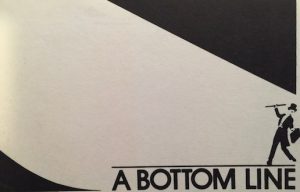 During my second year in business school, I co-produced the annual student variety show. My co-producer and I ended up dipping into our own shallow wallets to cover budget overruns. To the best of my knowledge, it was the first time the show produced an artistic success and a financial failure. That was a decidedly un-business school result. Although we named the show “A Bottom Line†in homage to “A Chorus Line,†we lost sight of our bottom line in pursuit of our vision.
During my second year in business school, I co-produced the annual student variety show. My co-producer and I ended up dipping into our own shallow wallets to cover budget overruns. To the best of my knowledge, it was the first time the show produced an artistic success and a financial failure. That was a decidedly un-business school result. Although we named the show “A Bottom Line†in homage to “A Chorus Line,†we lost sight of our bottom line in pursuit of our vision.
This was probably the harshest lesson I took away from theater as laboratory. Art and economics do not coexist without effort. Balancing them demands vision and craft. I can’t prove that pursuing one over the other leads to failure, but success always seems to correlate with making the partnership effective.
I wrestle with why this simple observation should seem so hard to grasp. Perhaps, those who cling to either pole—art or economics—secretly want to have a ready excuse for mediocrity. How much easier it is to blame the “suits†for paying more attention to the budget than to the audience. Or to blame the director for wasting that budget on sets that no one cared about.
The tension between art and economics is no new thing. The lesson I learned over time was the more nuanced relation between vision and detail. Any new product or service depends on a tapestry of interlocking details that each contribute to the overall experience. Too often, it is the interweaving that gets forgotten. As organizations strive to fit new ideas and processes into the existing design, crucial details get sanded off or forgotten in the gaps between jurisdictions. In last year’s Academy Awards ceremony, the presenters on stage announced the wrong winner for Best Picture. The error traced back to a momentary lapse offstage in managing the envelopes because there were two sets of envelopes to deal with the detail of not being certain where the presenters would enter from. A huge gaffe in front of the world traces back to a design detail that missed one possible failure mode.
There’s a collection of useful lessons to be gleaned from a detailed post-mortem of this particular mix up. The broader lesson is that no one looked at how little changes in the details of a long-running process put the broad vision at risk. The lesson from my theater experience is that there is always a level of chaos playing out offstage that is essential to maintaining the illusion of control on stage. If you don’t recognize this and factor it into your designs and your management practices, then the offstage chaos is going to spill into view.